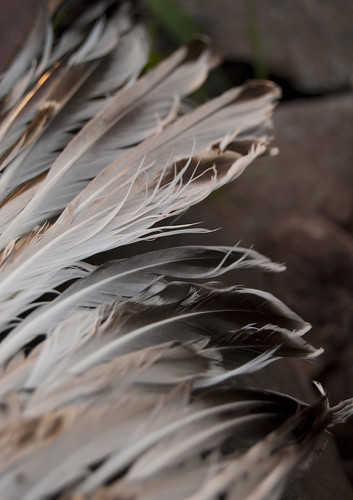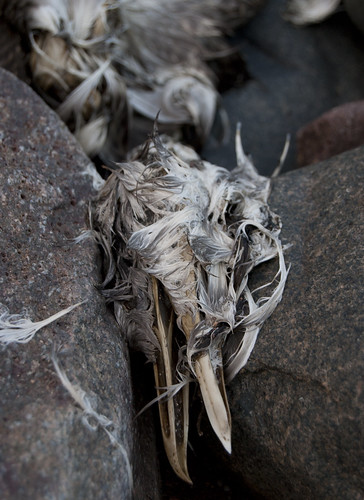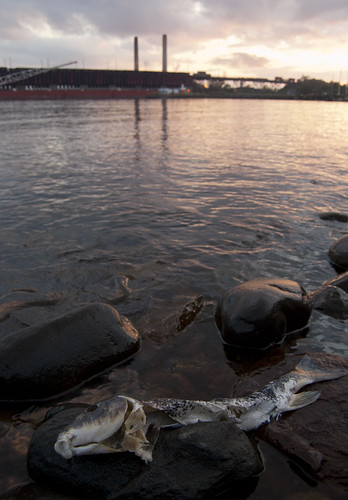Almost immediately, we found the remains of two different gulls. Not much was left of either bird, except for the wings, and on one of the gulls, the wishbone. Judging by the few feathers that were present, they were both juveniles, and probably ring-billed gulls.

The sun was setting fast, so Steph and I continued to work our way along the rocky beach. Quite suddenly, we encountered a foul stench, and I soon found the source: the rather-fresh body of a carp. Unlike the carp skeleton found in June, this carp still had its skin and scales; its eyes, however, were missing, and a large chunk had been taken out of the body. I'm not very well-read on the natural predators of carp -- are there any? I'm sure they're prey for eagles. Anyway, I assume that the damage to the body was done postmortem, either by scavengers or by the repeated washing up against the rocks.
The setting sun was casting a wonderful, rosy light, but the carp was mostly-submerged in the water. I wanted to photograph its tail reflecting that beautiful sunset, so I pulled the (surprisingly heavy) carp out of the water and laid it over the dark rocks. Never again! Touching this carp pretty much felt like touching any other kind of (live) fish, but in its state of decay, it left my hands smelling awful.

The setting sun was casting a wonderful, rosy light, but the carp was mostly-submerged in the water. I wanted to photograph its tail reflecting that beautiful sunset, so I pulled the (surprisingly heavy) carp out of the water and laid it over the dark rocks. Never again! Touching this carp pretty much felt like touching any other kind of (live) fish, but in its state of decay, it left my hands smelling awful.

Steph made the next discovery, while I was still photographing the carp. It was the body of yet another juvenile gull, but this corpse was amazingly complete. It was also rather large, which makes me wonder if it was a herring gull. The body was draped over the rocks, in a state of advanced decomposition; the head, which was very much skeletonized, was wedged between two chunks of stone.


Unlike the carp, this gull didn't have a horrible smell. Curious about what the other side of the head looked like, I lifted it, and was unsurprised to find tiny maggots squirming about. I think I might return today to take more photographs, but bodies along the beach are very impermanent, and this gull -- and very likely, the carp -- might not still be there this afternoon.
As we headed back, I took a parting shot of the carp, the sun setting over the body. In the background, the freighter Great Lakes Trader can be seen at the ore dock, being filled with taconite pellets.
As we headed back, I took a parting shot of the carp, the sun setting over the body. In the background, the freighter Great Lakes Trader can be seen at the ore dock, being filled with taconite pellets.





No comments:
Post a Comment